Question
QUESTION 11 Obedience O Compliance with commands given by an authority figure Tendency to explain someone's behavior based on internal or dispositional factors and
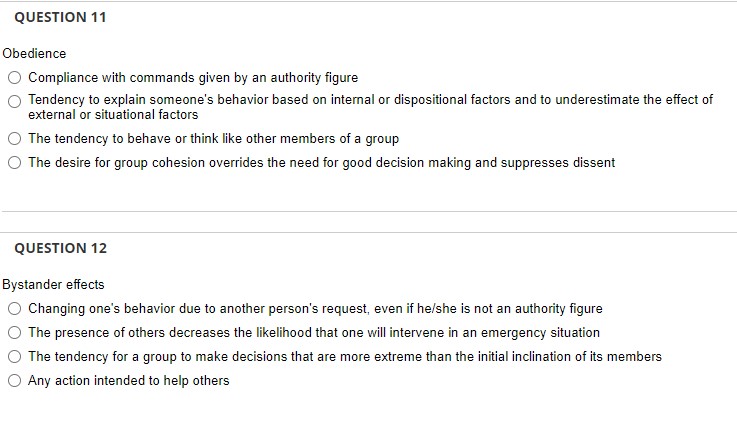

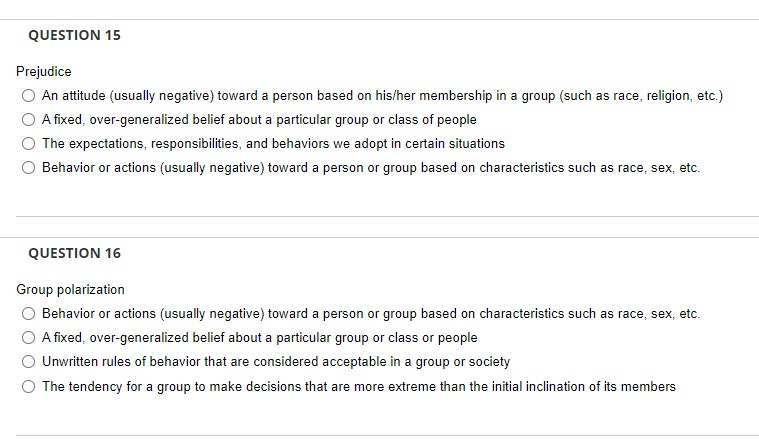
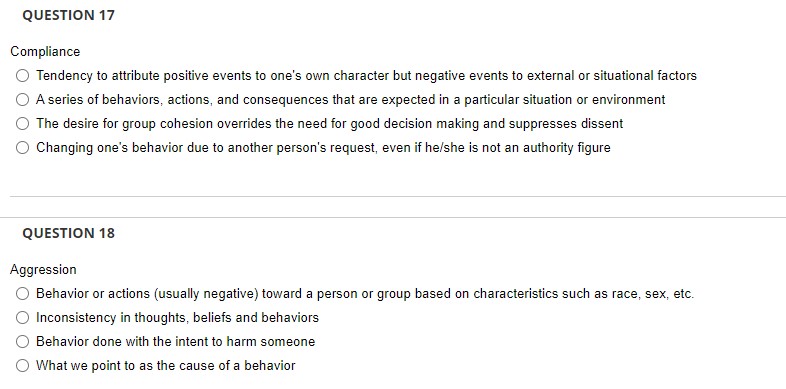
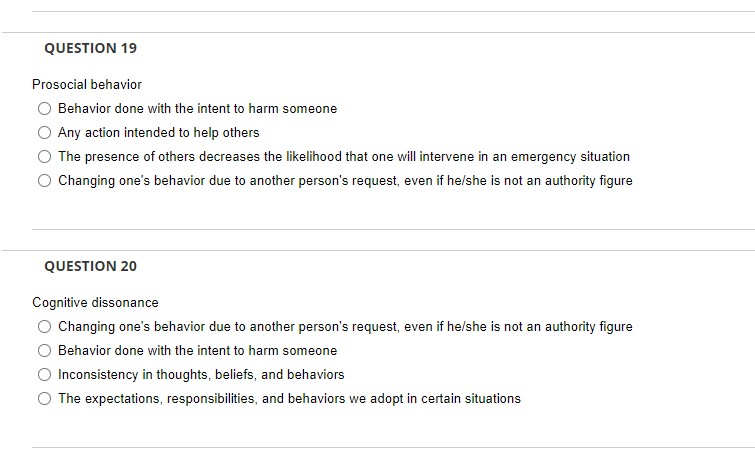
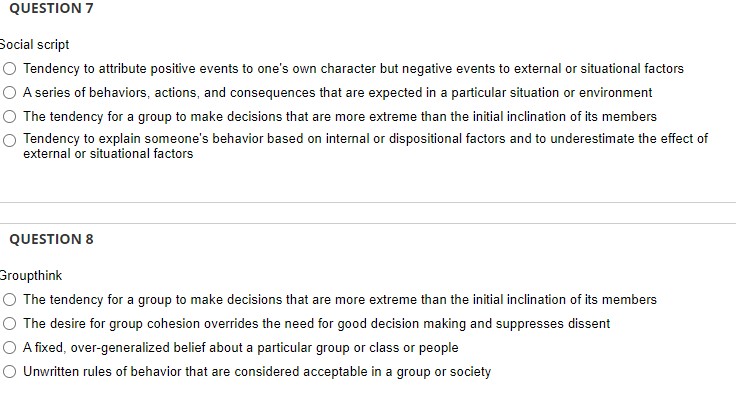

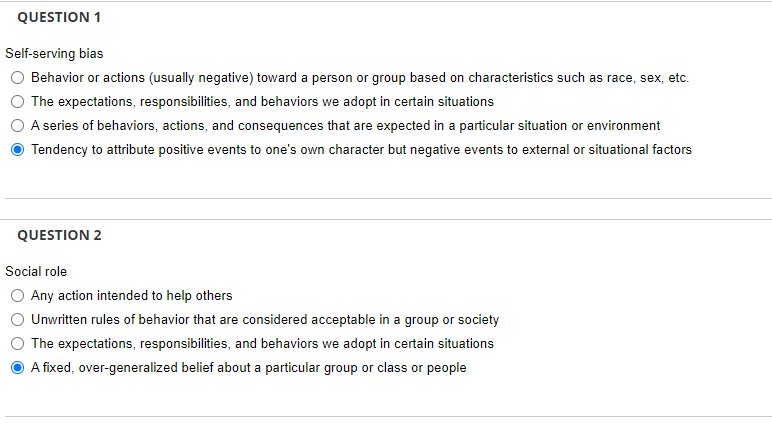
QUESTION 11 Obedience O Compliance with commands given by an authority figure Tendency to explain someone's behavior based on internal or dispositional factors and to underestimate the effect of external or situational factors The tendency to behave or think like other members of a group The desire for group cohesion overrides the need for good decision making and suppresses dissent QUESTION 12 Bystander effects Changing one's behavior due to another person's request, even if he/she is not an authority figure The presence of others decreases the likelihood that one will intervene in an emergency situation The tendency for a group to make decisions that are more extreme than the initial inclination of its members Any action intended to help others QUESTION 13 Central route of persuasion Evaluating a message based on surface-level characteristics rather than on the actual content of the message Compliance with commands given by an authority figure One is persuaded by facts, logic, or the content of a message A series of behaviors, actions, and consequences that are expected in a particular situation or environment QUESTION 14 Conformity Compliance with commands given by an authority figure The presence of others decreases the likelihood that one will intervene in an emergency situation The tendency to behave or think like other members of a group A fixed, over-generalized belief about a particular group or class or people QUESTION 15 Prejudice An attitude (usually negative) toward a person based on his/her membership in a group (such as race, religion, etc.) A fixed, over-generalized belief about a particular group or class of people The expectations, responsibilities, and behaviors we adopt in certain situations Behavior or actions (usually negative) toward a person or group based on characteristics such as race, sex, etc. QUESTION 16 Group polarization Behavior or actions (usually negative) toward a person or group based on characteristics such as race, sex, etc. A fixed, over-generalized belief about a particular group or class or people Unwritten rules of behavior that are considered acceptable in a group or society The tendency for a group to make decisions that are more extreme than the initial inclination of its members QUESTION 17 Compliance Tendency to attribute positive events to one's own character but negative events to external or situational factors A series of behaviors, actions, and consequences that are expected in a particular situation or environment The desire for group cohesion overrides the need for good decision making and suppresses dissent Changing one's behavior due to another person's request, even if he/she is not an authority figure QUESTION 18 Aggression Behavior or actions (usually negative) toward a person or group based on characteristics such as race, sex, etc. Inconsistency in thoughts, beliefs and behaviors Behavior done with the intent to harm someone What we point to as the cause of a behavior QUESTION 19 Prosocial behavior Behavior done with the intent to harm someone Any action intended to help others The presence of others decreases the likelihood that one will intervene in an emergency situation Changing one's behavior due to another person's request, even if he/she is not an authority figure QUESTION 20 Cognitive dissonance Changing one's behavior due to another person's request, even if he/she is not an authority figure Behavior done with the intent to harm someone Inconsistency in thoughts, beliefs, and behaviors The expectations, responsibilities, and behaviors we adopt in certain situations QUESTION 7 Social script Tendency to attribute positive events to one's own character but negative events to external or situational factors A series of behaviors, actions, and consequences that are expected in a particular situation or environment The tendency for a group to make decisions that are more extreme than the initial inclination of its members Tendency to explain someone's behavior based on internal or dispositional factors and to underestimate the effect of external or situational factors QUESTION 8 Groupthink The tendency for a group to make decisions that are more extreme than the initial inclination of its members The desire for group cohesion overrides the need for good decision making and suppresses dissent A fixed, over-generalized belief about a particular group or class or people Unwritten rules of behavior that are considered acceptable in a group or society QUESTION 9 Attribution What we point to as the cause of a behavior One is persuaded by facts, logic, or the content of a message Tendency to explain someone's behavior based on internal or dispositional factors and to underestimate the effect of external or situational factors An attitude (usually negative) toward a person based on his/her membership in a group (such as race, religion, etc.) QUESTION 10 Peripheral route of persuasion Tendency to explain someone's behavior based on internal or dispositional factors and to underestimate the effect of external or situational factors Inconsistency in thoughts, beliefs, and behaviors One is persuaded by facts, logic, or the content of a message Evaluating a message based on surface-level characteristics rather than on the actual content of the message QUESTION 1 Self-serving bias Behavior or actions (usually negative) toward a person or group based on characteristics such as race, sex, etc. The expectations, responsibilities, and behaviors we adopt in certain situations A series of behaviors, actions, and consequences that are expected in a particular situation or environment Tendency to attribute positive events to one's own character but negative events to external or situational factors QUESTION 2 Social role Any action intended to help others Unwritten rules of behavior that are considered acceptable in a group or society The expectations, responsibilities, and behaviors we adopt in certain situations A fixed, over-generalized belief about a particular group or class or people
Step by Step Solution
There are 3 Steps involved in it
Step: 1

Get Instant Access to Expert-Tailored Solutions
See step-by-step solutions with expert insights and AI powered tools for academic success
Step: 2

Step: 3

Ace Your Homework with AI
Get the answers you need in no time with our AI-driven, step-by-step assistance
Get Started


